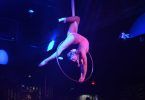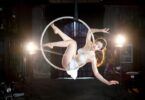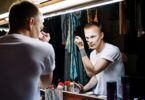Welcome to our exclusive interview with Grace Ramsey, an accomplished aerialist specializing in silk, hoop, hammock, and freestanding hoop. Based in Denver, Colorado, Grace shares her insights, experiences, and passion for aerial arts. Join us as we delve into her journey, favourite apparatus, and her latest fascination with “lyrapop.”
Grace Ramsey Introduction
Grace Ramsey is an aerialist in aerial silk, aerial hoop, hammock, and freestanding hoop based in Denver, Colorado. She has over five years of performance experience including nightclubs, festivals, cruise ships, and national tours. Her favourite apparatus is the aerial hoop. She started off with silk and that was her passion for six years, but for her, the hoop was a perfect fit! She loves the dynamism and flexibility of it. Apart from the hoop, she is obsessed with something else. Something new that she lovingly calls “lyrapop”. What is that actually? She explains that and much more, below in her exclusive interview.
Grace we would wholeheartedly like to thank you for accepting our invitation and honouring us with your interview that is hosted here on Vertical Wise. How often do you do performances?
The pleasure is mine! I perform weekly at The Mansion Nightclub in Colorado Springs as well as taking corporate gigs and other opportunities every few weeks.
What is it about aerial arts that you love so much and which aerial apparatus is your favourite?
Aerial is an experience nothing short of spiritual for me. I feel so lucky to be performing and to be good at it. It’s a calling, so I feel grateful every time I touch my apparatus; a feeling like everything is right with the world. My favourite apparatus is the aerial hoop. I started off with silk and that was my passion for six years, but the hoop is just a fit. I love the dynamism and flexibility of the hoop. I’ve started working on a hoop/pole hybrid I lovingly call my “lyrapop” and I’m obsessed with that too. However I’m only learning, I’m not as clean and smooth as I wish I could be, so that comes in second. It will soon overtake the hoop though. I love it!

How dangerous is your profession?
Of course, aerial comes with an element of danger, but I have a friend who is a stuntman in China and his job is far more dangerous than mine. The key to practising aerial safely (after rigging and the integrity of your apparatus) is situational awareness. Be aware of where you are and what your apparatus is doing as well as your body, and you’ll be okay.
Do you choreograph your own routines and if yes, what/who is your inspiration?
I do choreograph my own routines. Because I do a lot of nightclub work and ambience, I usually just string together sequences and keep them clean in their execution. But on the occasion I get to perform in a show where I have creative liberty, I take my inspiration from a theatrical standpoint. I create a character in my mind and try to perform as that character would. For instance: Who is she? What is she? What does the apparatus represent to her and how would she choose to interact with it? I’m inspired by mythology and classic literature. I work with actors and directors in my area to hone my theatrical skills, and I feel like it helps me stand out in my scene.
What would you say that is one of the toughest parts of the job?
For me personally, I have a hard time keeping up my appearance. My natural state is “ragamuffin.” I love my hippie bell bottoms and forgoing bras under my tank tops. I can get downright sloppy. However, I learned the hard way that there’s no such thing as an off-duty circus artist. We need to look put-together and glamorous: hair done, neat make-up, and clean, stylish clothing are a must. The hardest part for me is keeping in the right shape. I’ve had my job threatened over my weight before. Sometimes it feels arbitrary and means; sometimes it’s warranted. It’s easy to just assume that because you’re working out so much that you can eat whatever you want. Some people can get away with that, but I can’t. It’s a daily struggle.
How many hours do you have to practise in a week and what does your typical training day look like?
I train around three hours per day, four to five days per week. I start with a long contortion-style warm-up, which actually takes longer than any training on my apparatuses – up to two hours. Then I get on my apparatus and work on cleaning up a new move or sequence and integrating it into more sequences. Then I work on endurance. I get in the air and I stay there for up to twenty-five minutes at a time. I’ll come down for water then go back up again for another set. If I’m developing a routine for a show, I rehearse it top to bottom until I’m tired; then I do it again to build muscle memory.

If we asked you to provide a training tip or advice to our readers, what that would be?
Know your limits. Don’t sacrifice technique for bragging rights. Most especially, don’t compare yourself to others! They have their gifts; you have yours. You don’t know their backgrounds or how hard they worked to get where they are. If you compare yourself to them and get competitive, you will hurt yourself, that’s a guarantee. Focus on yourself and your journey.
What are your future goals?
I’m not sure! I’m starting to enter the competitive circuit now; I’m hoping to gain further visibility in the community. After that, I would love to do more avant-garde style shows that push the envelope of what circus art is. I want to travel the world.

If not aerial arts, what else?
Contortion! I’m just beginning to learn, but I’m totally obsessed! But if your question is “if not circus arts, what else,” then my answer is art. I studied Fine Arts in college and I really enjoy painting with unexpected materials like nail polish or ballpoint pen ink. I like to work large scale. I had one of my murals featured in the AP wire last year, which was pretty exciting.
What has been the most terrifying/funny moment in performance to date?
The first time I rigged my fabric off the Royal Arch outside of Boulder, Colorado. It was right next to the flat irons and I swear I could see Kansas from my vantage point. The arch was made of two monolithic boulders and was something like fifty feet high. I had never felt adrenaline like that. The view was incredible and the experience humbling. I didn’t feel small at all. In fact, I felt enormous; like I took up the whole space, like I was the Earth itself. That’s terrifying in a way because you expect to feel small, but instead, you’ve tapped into a very powerful force. If you aren’t prepared for it, it’s overwhelming. Also, fifty feet is REALLY high.

Would you like to work abroad?
Absolutely! I’m living with a terrible case of Wanderlust. I would love to get on an international level with my performance.
Where we could find you in this time period/season?
This Autumn I’m hoping to hear back about a few competitions I’m entering. After that, who knows?
Epilogue
As we conclude this interview, we extend our heartfelt gratitude to Grace Ramsey for sharing her experiences and wisdom in the world of aerial arts. Her dedication, creativity, and continuous pursuit of excellence are truly inspiring. We wish her the best in her future endeavours and look forward to witnessing her soar to new heights in the international performance arena.
Thank you, Grace Ramsey!








